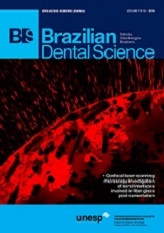Durability of silorane repair with silorane and methacrylate resin.
DOI:
https://doi.org/10.14295/bds.2014.v17i2.971Abstract
Objective: The durability of bonded interface between silorane (SIL) and methacrylate-based (MET) composite resins wasn’t investigated yet. The purpose was to evaluate the repair strength (RS) and nanoleakage of the SIL repair using silorane- or methacrylate-based materials immediately [IM] or after 6 months of water storage [6M]. Materials and Methods: fifteen resin blocks (Filtek P90, 3MESPE) were polished, sandblasted with 50-µm aluminum oxide sandblasting and cleaned with 37% phosphoric acid. Then the specimens were divided into three groups: SIL-SIL (adhesive and composite resin); SIL-MET (silorane adhesive and methacrylate based composite) and MET-MET (methacrylate-based adhesive and composite resin) were used for the repair. Composite-composite bonded sticks (0.9 mm2) were sectioned and divided to be tested in tension (1.0 mm/min) IM or 6M. Two sticks from each tooth, at each time, were immersed in a 50% silver nitrate solution and evaluated by SEM. Data were analyzed by two-way repeated measures ANOVA and Tukey´s tests. Results: The RS of the SIL was not dependent upon the adhesive and composite used for the repair. A significant reduction of the RS was observed for all groups after 6M. Conclusions: Both materials can be used for the repair of the silorane composite, despite degradation occur after 6M.
Downloads
Downloads
Additional Files
Published
How to Cite
Issue
Section
License
Brazilian Dental Science uses the Creative Commons (CC-BY 4.0) license, thus preserving the integrity of articles in an open access environment. The journal allows the author to retain publishing rights without restrictions.
=================




























